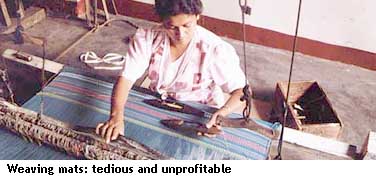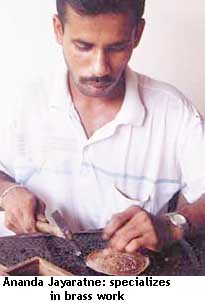

![]()
There are no parallels to the Kandyan splendour and heritage. Kandy is not only a place of religious significance, but a hub of activity and a modern city with all the trappings. And the allure of Kandyan crafts has never dulled despite changing lifestyles.
 But
there are people whose lifestyle and financial situation have remained
static despite the economic changes sweeping the country. Struggling to
perpetuate the arts and crafts of yesteryear, the traditional Kandyan craftsmen
are a deprived lot.
But
there are people whose lifestyle and financial situation have remained
static despite the economic changes sweeping the country. Struggling to
perpetuate the arts and crafts of yesteryear, the traditional Kandyan craftsmen
are a deprived lot.
Despite the boom in tourism industry, the benefits have not filtered down to the craftsmen. Skilled jewellers and traditional craftsmen are still struggling to secure a non- Kandyan based market for their products.
Kandyan crafts are distinct from any other, with old designs still rctainig prominence. Of all the Kandyan products, traditional jewellery and brass products have a larger market. According to the craftsmen, there are specific items like the stone-studded silver elephants, woodworks, silver jewellery and certain brass pieces which are attractive to foreigners. Brass lamps, silver plaques and lacquer works are more popular among locals.
 Ananda
Jayaratne is a traditional craftsman who has specialized in brasswork.
Seated in a corner at the Kandyan Art Association, his head bent low, he
is the epitome of patience and skill, as he quietly works with a small
chisel and hammer. He has a small brass plate fixed securely onto a wooden
board plated with a generous layer of wax.
Ananda
Jayaratne is a traditional craftsman who has specialized in brasswork.
Seated in a corner at the Kandyan Art Association, his head bent low, he
is the epitome of patience and skill, as he quietly works with a small
chisel and hammer. He has a small brass plate fixed securely onto a wooden
board plated with a generous layer of wax.
It takes only minutes for him to create a small ash tray with an intricate pattern of a swan, which he carefully removes after heating the wax, then polishing the finished product within a few minutes. Some designs are easily recreated, while heavy designs take about two days to complete. But all these orders are created with the chisel and hammer only- two traditional tools used by craftsmen for generations. His ancestors have all been either jewellery makers or suppliers of artefacts to the Kandyan King. He recreates some of the traditional jewellery on order without taking the risk of not having a market for the work he has painstakingly made.
"This trend led to a virtual abandoning of jewellery making trade by my family. I began working on brass. My works are sold to either the Kandyan Art Association or Small Industries. My products are mostly purchased by people who want to redecorate their homes with traditional artefacts. Occasionally, if time permits, I indulge in a little bit of wood carving which is becoming increasingly popular, and shows all signs of becoming the newest trend in home decor," says Jayaratne.
Mr.Jayaratne was a student of Sri Mayurapada Vidyalaya, Mawanella when his craftsman father commenced giving him basic lessons on working with brass. Gradually he developed his own clientele in the area. In 1984, he became a registered supplier of the Kandyan Art Association.
"If I knew any other trade, I would probably practise that. We were born into a tradition which is not easy to break away from. I love to create something new. It is this joy which makes us stick to the profession. Our market is not picking up, and there are perennial financial constraints. We cannot charge excessively for our labour, but it is difficult to sell at these rates," he said.
He has to purchase his own materials and necessary tools which are costly. He is unable to increase the prices accordingly for that would make them expensive and therefore unmarketable. For the tourists, the prices are increased marginally. Yet, his monthly income never exceeds Rs.5,000 except seasonally.
Mrs. W. M. Suriarachchi has been a wood carver for the last thirty years. Having married a traditional craftsman at the age of twenty one, she took to wood carving like a duck to water. Having taken basic lessons from her husband, she soon developed her individual style, and found a market of her own. Later, she acquired training in the art of wood carving from a professional centre.
"It is the family influence. My husband taught me traditional designs. Subsequently I experimented with new designs. With the introduction of the tourism industry twenty years ago, we expanded our vistas, and commenced non-traditional carving. But our fortunes are always fluctuating, as there is no standard market to cater to," she says.
Mrs. Suriarachchi is presently serving at the Bakamuna Training Centre as an instructor, where over twenty students are being trained in the art of ancient and modern methods of wood carving. In addition, she accepts orders from various home decor and other institutions as well as individuals. The majority of her works are purchased by the Kandyan Art Association which has a large local and foreign clientele.
An art which was alien to Sri Lanka for a long time is lacquer painted works. It is believed this craft was unknown to Sri Lanka until Arahat Mihindu's visit over 2,000 years ago, accompanied by monks and thirty six leading artists from India. While religious propagation was done by the monks, the artists shared their knowledge of Indian crafts with the local people.
D.B.G. Devendra claims to be a direct descendent of the first lacquer artist who stepped on to the shores of this isle accompanying Arahat Mahinda; a matter which makes him immensely proud of his South Indian ancestry and the history of the craft he practices.
Lacquer work during the Kandyan kingdom was confined to royalty. Only the kings enjoyed the privilege of decorating their palaces, temples and other significant places with lacquer products out of which the most popular was the traditional 'Sesathas' and stone- studded mahogany elephants.. Centuries ago, the colour combinations were static, with red, yellow and black gaining prominence. These were known as royal colours. Colours were created mostly from plant extracts, like bulu, saffron and vegetable dyes.
It is a labour of love for Devendra who takes two days to add the intricate patterns to a completed 'Sesatha' while smaller items are completed within a shorter period of time. Tiny bulu threads are removed from the bark of the tree, and are dipped in the plant -extracted colours. The painted threads are first heated and then plastered according to the design. It is an awe inspiring intricate craft which demands extreme patience and finesse. The slightest mistake would destroy the design and diminish the value of the product.
The artists claim they have no financial stability, and there is no proper marketing strategy to ensure them a permanent market. They are faced with immense risks and financial burdens, a problem that could be solved only by state intervention and support. The problem needs to be resolved fast to ensure perpetuation of our ancient arts and crafts.
Continue to Plus page 5 * Who says there is no war in Colombo? * Reality of war and our ignorance
Return to the Plus contents page
![]()
| HOME PAGE | FRONT PAGE | EDITORIAL/OPINION | NEWS / COMMENT | BUSINESS
Please send your comments and suggestions on this web site to
info@suntimes.is.lk or to
webmaster@infolabs.is.lk